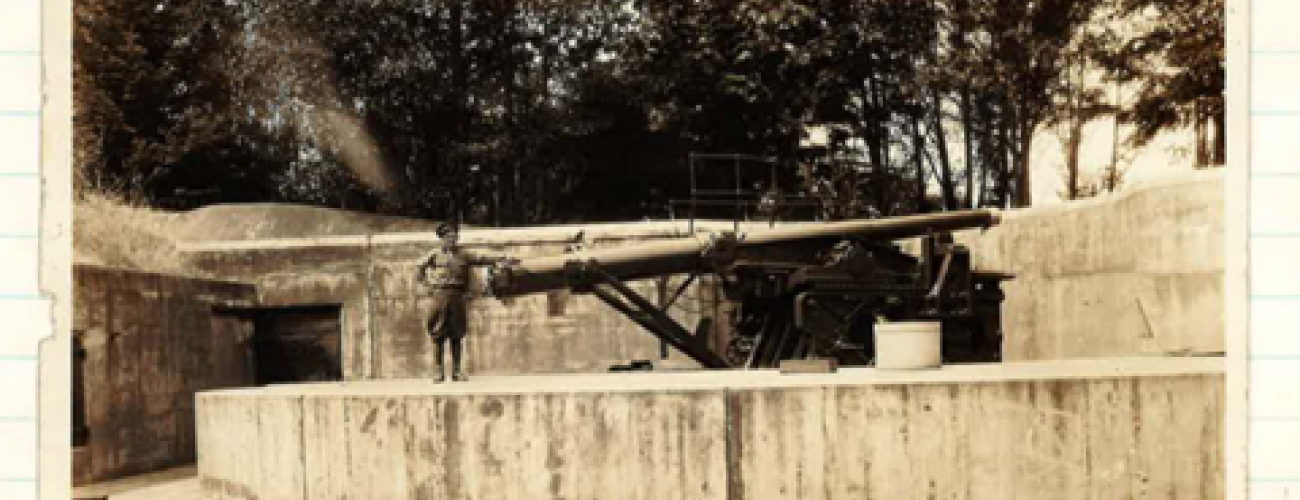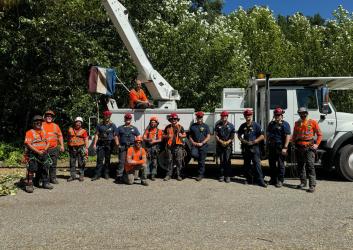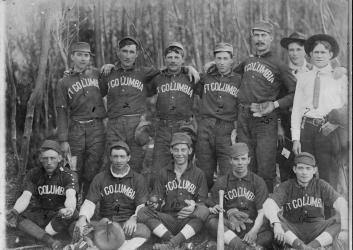Life of Bessie, 1892 - 1987, part II
The short, chilly days make this the perfect time to catch up on some reading. May we suggest tucking yourself into a chair with a blanket and a cup of tea to continue with the extraordinary life of Bessie?

Where we left off
As you may remember from the first installment of Ms. Bessie Virginia Charawell-Jarboe-Koudal's life story, we ended with her husband Sergeant Matthew (Matt) Jarboe returning home from World War I. This was to be the “War to end all wars” and thus life was very different afterwards. Many of the coast defense forts were deactivated and placed in caretaker status, meaning a select few solders were left to maintain the grounds, structures, and remaining guns. One such fort placed in caretaker status was Fort Whitman on Goat Island, and Sgt. Jarboe was chosen for the opportunity to act as Commanding Officer of this small, six-man detachment (that dwindled to a two-man detachment).
Fort Whitman was a smaller version of Fort Worden. You could say it was a back-up coastal defense fort. Fort Worden, Fort Flagler, and Fort Casey guarded the main deepwater channel into Puget Sound to protect the Naval shipyard in Bremerton. This would have been the most likely route that a fleet of enemy vessels would have taken to enter the sound. However, there is another way in through Deception Pass. That’s why Goat Island became the perfect location for back-up defenses.

Queen of Goat Island
Now back to Bessie! One of the reasons her husband was chosen to oversee Fort Whitman was because Bessie did not mind living an isolated lifestyle and serving as the cook for the men stationed at the outpost. So, in August of 1919, the Jarboes (now a family of five and Bessie’s mother) moved to Goat Island!
Due to their remote location, family life and work life became very much intertwined. With much work to be done, a routine was quickly established among the men and Bessie’s family.
The soldiers were allocated a monthly ration to manage their supplies. Given their island setting, it was decided that Matt would take charge of purchasing provisions, and any remaining funds would be evenly distributed among all the men. Bessie noted that Matt was a “firm but fair leader”.
Bessie took care of meal planning but quickly realized the task of cooking for everyone was too much for her to handle on her own. So, she sought the assistance of the men. “Nicer young men could never be found if you were to search the whole world over.”

Plus, it didn’t hurt that their option was to either help the engineers or assist Bessie in the kitchen. Once the money and food matters were settled, they decided to improve their working conditions. Using their Great Majestic Range, they connected it to their water heater and replumbed the house to have both hot and cold running water. However, Bessie notes that the “Big Old Army Range was hard to bake in”. They ended up purchasing bread, pies, and cakes from Fahlen’s Bakery in La Conner, but Bessie managed to figure out the secret to making puddings and custards, which were “gobbled” up by the men as quickly as they were made.
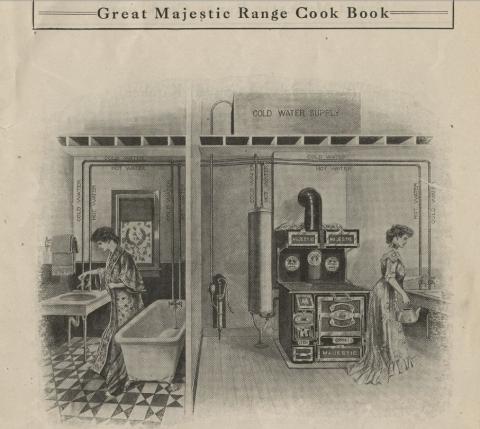
Their house at Fort Whitman was originally built to serve as Army Engineer’s office during the construction of the fort.
Bessie writes, "It was located at the edge of the high bluff above the river... overlooking Skagit Bay and The Battery...” Matt built a sturdy fence along the bluff, "so none of the children would fall into the river.”
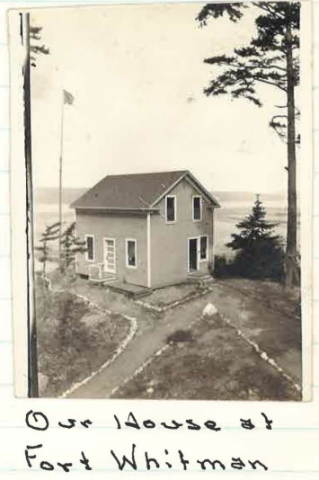
Island life
Their daughter Lois was now of school age, and of course Fort Whitman did not have a schoolhouse. Matt found living quarters in La Conner for Bessie’s mother and Lois to stay during the school week. On weekends Bessie would take the girls, Lois and Joyce, on hikes around the island. They became very interested in the wildflowers that decorated the landscape. They always had a fresh bouquet on the dinner table and often gave bouquets to Lois’ teacher.
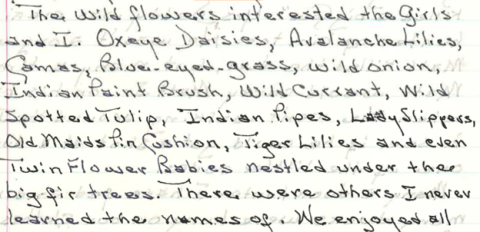
Their son, Matt Jr., by contrast loved hiking around the island with Matt when he went duck hunting. The marshy edges of Dugualla Bay (the waterway between Fort Whitman and Dugualla Bay State Park) was prime habitat for hundreds of ducks. Bessie described Matt as a natural hunter and, as such, they had duck regularly for dinner. Plus, they always had feather pillows. Officers from Fort Worden and Seattle would often visit to hunt and feast with the family. So, Bessie learned to cook duck every which way!
The fishing was also good and provided a way for the men to earn extra money. Military rules for a fort in caretaker status were very lenient.
Bessie stated that, “As long as everything was kept in good order, and everyone shared equally in the work, they could do pretty well as they pleased.”
However, they were not permitted to fish on the ‘Government Island’ without expressed permission. Matt and the men learned from locals how to fish for smelt and salmon. The ate some of what they caught but shipped most to Seattle for commercial sale and everyone shared in the profits.
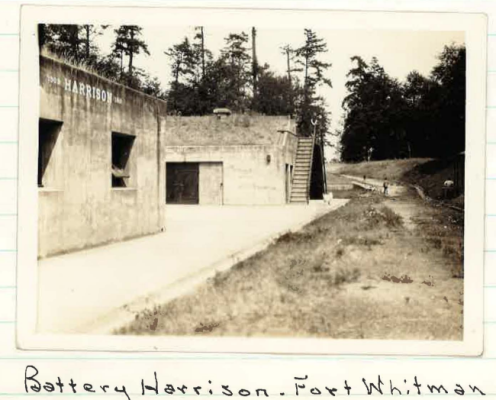
Fort Whitman in the later years and retirement
Between 1919 and 1931, “Fort Whitman’s upkeep became less and less important.” The crew was eventually just Matt and one other man. Though the guns stayed greased, the only real threat were vandals.
Throughout those years their family continued to grow. In 1922 they had another son, James, otherwise known as Jim. And with a fifth child on the way in 1927, it became easier for Bessie and the family to live in La Conner during the winter months. On nice weekends, they would visit Matt on the island.
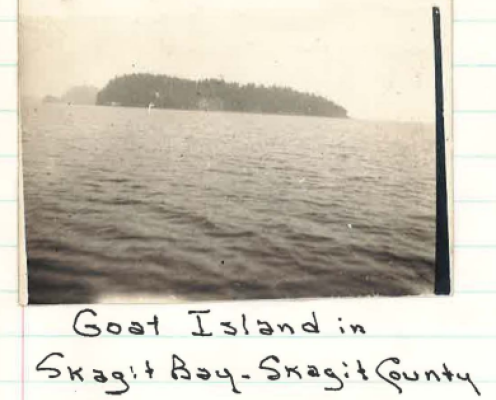
In good times and sad times
A couple of years after June was born, tragedy struck. Their third child, Matt Jr. fell ill with pneumonia. Just as he seemed to be on the mend, his heart ruptured from overexertion during the fever. Matt Jr. was laid to rest in Fort Worden’s Cemetery at 10 years of age.
“It was during this time of sorrow that we first knew of the Rasmus Koudal Family,” Bessie wrote.
Mrs. Koudal’s sister was a teacher in town. When Mrs. Koudal heard what had happened, even though she didn’t know Bessie’s family directly, she wrote a kindhearted, sympathetic note to the family during their time of grief.
On July 31, 1931, Matt officially retired from his service with the Army. They initially rented a house in La Conner that neighbored the Koudal farm, and the families became fast friends. But soon, they became interested in owning a house of their own.
They located a two-story, seven-room home that they were able to purchase for $2,000 with $25/month payments!
“We were so happy we could hardly contain ourselves and was Matt ever in his glory cleaning up that yard,” Bessie wrote.
Matt worked as La Conner’s Marshall (a one-man police force) for about three years before joining the U.S. Army Engineers as a guard in 1935. Though he was away from the family quite a bit, he made good money, which allowed them to pay off their home by 1942.

Tragedy strikes again and a new path is forged
Thanksgiving night in 1942, changed the path of Bessie’s life forever. Matt was working at the guard house along a closed road when he noticed the headlights of a car coming towards him. He stepped out and waved his flashlight to alert the car to stop.
Unfortunately, the driver and passengers had been drinking and didn’t notice. Matt was struck, but thankfully the car stopped, picked up Matt, and drove him to the hospital. As it turned out, the men in the car were servicemen from Fort Worden out on holiday.
Bessie received a phone call at 3 a.m. and rushed to the hospital. She was so thankful to be with him during his final moments. Matthew Jarboe, 1st Sergeant of the U.S. Army, was buried at Fort Worden along with his late son William Matthew Jarboe Jr.

As Bessie recounted this terrible time, she wrote the following:
“I was grief-stricken and felt so incapable of coping with life on my own. As I look back now, I feel my family and friends must have thought I was a pretty spineless woman. To feel so helpless when in reality I had my health and home free of debt and a lovely family, the youngest in high school. But I was scared… life with Matt Jarboe was, from start to finish, a loving, sharing, caring experience. I adored him. We had a closeness so precious that I wish all my loved ones could experience the same.”
Her friends and family comforted her and supported her through the holidays, but as the new year dawned, so did new challenges for Bessie.
“I needed a job,” Bessie said.
For the next thirteen years Bessie worked in the offices of the Puget Sound Seed Company, San Juan Island Pea Cannery, U.S. Naval Air Station and the Whiz Fish Company.
“One thing though. I proved I could make my own way…” she wrote.

A second chance at love
Rasmus Koudal and Bessie had stayed in touch as friends over the years. After some time as a widower, he realized that he didn’t want to live alone, and Bessie felt the same way. They were married on June 24, 1955.
Though Bessie outlived Rasmus as well, they lived a wonderful life together on his peaceful farm, surrounded by friends and family. Bessie recalled that a major highlight of their life together was their magical trip across Europe. Her life with Rasmus was “a serene happiness I never dreamed was again attainable.”
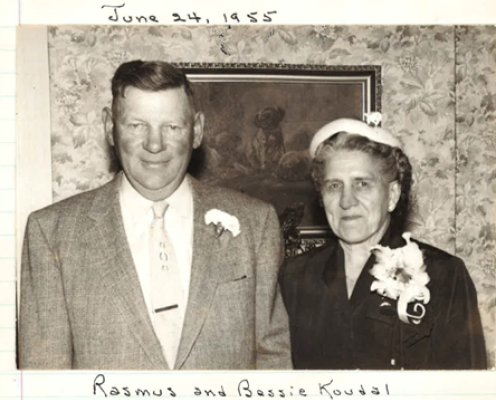
From growing up amongst the oyster bars of Bay Center, to life as an sergeant’s wife and motherhood, to becoming a working and fully independent women, to finding love and companionship once more, Bessie truly lived a full and remarkable life of 95 years.

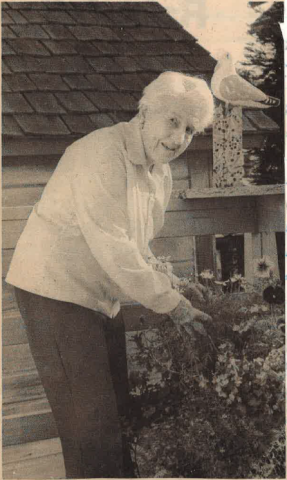
Originally published October 08, 2024

